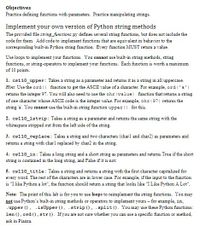
Database System Concepts
7th Edition
ISBN: 9780078022159
Author: Abraham Silberschatz Professor, Henry F. Korth, S. Sudarshan
Publisher: McGraw-Hill Education
expand_more
expand_more
format_list_bulleted
Concept explainers
Question
Please write in python. Thank you.

Transcribed Image Text:Objectives
Practice defining functions with parameters. Practice manipulating strings.
Implement your own version of Python string methods
The provided file sring_functions.py defines several string functions, but does not include the
code for them. Add code to implement functions that are equivalent in behavior to the
corresponding built-in Python string function. Every function MUST return a value.
Use loops to implement your functions. You cannot use built-in string methods, string
functions, or string-operators to implement your functions. Each funetion is worth a maximum
of 10 points.
1. cs110_upper: Takes a string as a parameter and returns it as a string in all uppercase.
Hint: Use the ord () function to get the ASCI value of a character. For example, ord ('a')
returns the integer 97. You will also need to use the chr (value) function that returns a string
of one character whose ASCII code is the integer value. For example, chr (97) returns the
string 'a'. You cannot use the built-in string function upper () for this.
2. cs110_1strip: Takes a string as a parameter and returns the same string with the
whitespace stripped out from the left side of the string.
3. cs110_replace: Takes a string and two characters (charl and char2) as parameters and
returns a string with charl replaced by char2 in the string.
4. cs110_in: Takes a long string and a short string as parameters and returns True if the short
string is contained in the long string, and False if it is not.
5. cs110_title: Takes a string and retums a string with the first character capitalized for
every word. The rest of the characters are in lower case. For example, if the input to the function
is "I like Python a lot", the function should return a string that looks like "I Like Python A Lot".
Note: The point of this lab is for you to use loop: to reimplement the string functions. You may
not use Python's built-in string methodas or operators to implement yours – for example, in,
. upper (), .isUpper (), .strip (), .split (). You may use these Python functions:
len (), ord (), str (). If you are not sure whether you can use a specific function or method,
ask in Piazza.
Expert Solution
This question has been solved!
Explore an expertly crafted, step-by-step solution for a thorough understanding of key concepts.
This is a popular solution
Trending nowThis is a popular solution!
Step by stepSolved in 2 steps with 5 images

Knowledge Booster
Learn more about
Need a deep-dive on the concept behind this application? Look no further. Learn more about this topic, computer-science and related others by exploring similar questions and additional content below.Similar questions
arrow_back_ios
arrow_forward_ios
Recommended textbooks for you
 Database System ConceptsComputer ScienceISBN:9780078022159Author:Abraham Silberschatz Professor, Henry F. Korth, S. SudarshanPublisher:McGraw-Hill Education
Database System ConceptsComputer ScienceISBN:9780078022159Author:Abraham Silberschatz Professor, Henry F. Korth, S. SudarshanPublisher:McGraw-Hill Education Starting Out with Python (4th Edition)Computer ScienceISBN:9780134444321Author:Tony GaddisPublisher:PEARSON
Starting Out with Python (4th Edition)Computer ScienceISBN:9780134444321Author:Tony GaddisPublisher:PEARSON Digital Fundamentals (11th Edition)Computer ScienceISBN:9780132737968Author:Thomas L. FloydPublisher:PEARSON
Digital Fundamentals (11th Edition)Computer ScienceISBN:9780132737968Author:Thomas L. FloydPublisher:PEARSON C How to Program (8th Edition)Computer ScienceISBN:9780133976892Author:Paul J. Deitel, Harvey DeitelPublisher:PEARSON
C How to Program (8th Edition)Computer ScienceISBN:9780133976892Author:Paul J. Deitel, Harvey DeitelPublisher:PEARSON Database Systems: Design, Implementation, & Manag...Computer ScienceISBN:9781337627900Author:Carlos Coronel, Steven MorrisPublisher:Cengage Learning
Database Systems: Design, Implementation, & Manag...Computer ScienceISBN:9781337627900Author:Carlos Coronel, Steven MorrisPublisher:Cengage Learning Programmable Logic ControllersComputer ScienceISBN:9780073373843Author:Frank D. PetruzellaPublisher:McGraw-Hill Education
Programmable Logic ControllersComputer ScienceISBN:9780073373843Author:Frank D. PetruzellaPublisher:McGraw-Hill Education

Database System Concepts
Computer Science
ISBN:9780078022159
Author:Abraham Silberschatz Professor, Henry F. Korth, S. Sudarshan
Publisher:McGraw-Hill Education

Starting Out with Python (4th Edition)
Computer Science
ISBN:9780134444321
Author:Tony Gaddis
Publisher:PEARSON

Digital Fundamentals (11th Edition)
Computer Science
ISBN:9780132737968
Author:Thomas L. Floyd
Publisher:PEARSON

C How to Program (8th Edition)
Computer Science
ISBN:9780133976892
Author:Paul J. Deitel, Harvey Deitel
Publisher:PEARSON

Database Systems: Design, Implementation, & Manag...
Computer Science
ISBN:9781337627900
Author:Carlos Coronel, Steven Morris
Publisher:Cengage Learning

Programmable Logic Controllers
Computer Science
ISBN:9780073373843
Author:Frank D. Petruzella
Publisher:McGraw-Hill Education